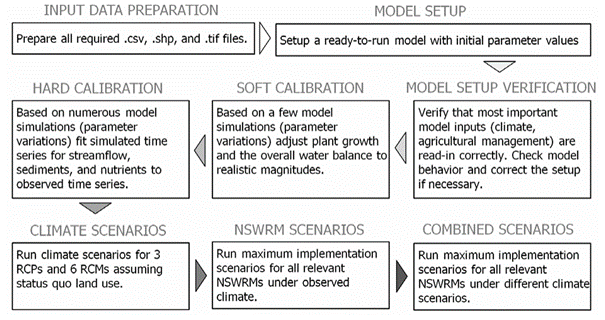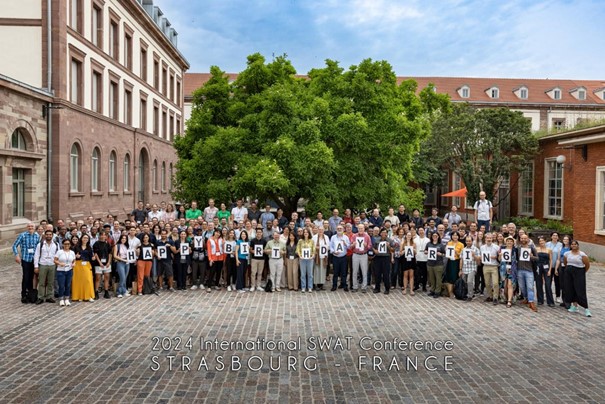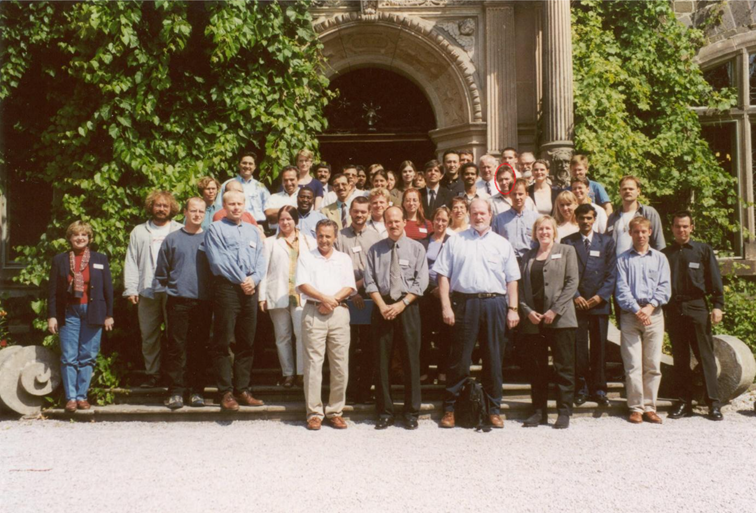New report on modelling the effectiveness of NSWRMs delivered and presented at the International SWAT Conference
For decades, computer models have been widely used to simulate hydrological processes, sediment and nutrient transport. One such model is the Soil & Water Assessment Tool (its most recent version abbreviated SWAT+) developed by the United States Department of Agriculture, Agricultural Research Service, and Texas A&M AgriLife Research Blackland Research and Extension Centre. SWAT+ was selected as a key modelling tool in the OPTAIN project to simulate the effectiveness of Natural/Small Water Retention Measures (NSWRMs) in 14 small agricultural catchments in Europe. In March 2024, a comprehensive report prepared by researchers from Warsaw University of Life Sciences (SGGW), Helmholtz Centre for Environmental Research (UFZ), Klaipėda University and University of Milano, entitled “Assessment of NSWRM effectiveness under current and future climate at the catchment scale” was delivered, bringing a first of this kind model-based assessment of NSWRMs in Europe and numerous innovations in the modelling workflow.
All SWAT+ model applications included in the report were prepared in a harmonised way and followed a consistent workflow designed to meet the desired objectives. In particular, all OPTAIN SWAT+ model setups were built using the new Contiguous Object COnnectivity Approach (COCOA) implemented in the new SWATbuildR package that can represent landscape features at the field scale and account for connectivity between land phase objects. This approach allowed for spatially explicitly representing selected structural NSWRMs (e.g., buffer strips, grassed waterways, ponds) at the Hydrologic Response Unit level. The report describes the modelling workflow, including input data preparation, model setup and its verification, calibration, and application in climate change and NSWRM scenario runs (Fig. 1).

Fig. 1 OPTAIN SWAT+ modelling workflow (source: OPTAIN deliverable 4.4).
This report presents a synthesis of modelling results, focusing on model evaluation, simulated water and nutrient balance, crop yield outputs, and the impacts of climate change from eight case studies in Belgium, Germany, Hungary, Italy, Norway, Poland, and Switzerland. It includes 14 annexes providing in-depth reports dedicated to specific catchments from all OPTAIN case study modelling teams. Seven annexes contain results on the simulated effectiveness of selected NSWRMs quantified by environmental performance indicators focusing on increasing water retention and reducing nutrient runoff. These preliminary results demonstrate the highest effectiveness of no-till and low-till practices and the added value of combining different measures together. The work on simulating NSWRM effectiveness will continue in OPTAIN under its WP5, focusing on identifying optimal implementation schemes for NSWRMs, including their combination and allocation within the catchment.
A significant achievement brought along with this deliverable is the development of a suite of scripted workflows in R that cover different steps of the SWAT+ modelling process. In particular, the new SWATprepR package supports input data preparation, while the SWATdoctR package helps verify model outputs' plausibility. Another tool under development is the SWATtunR package, assisting SWAT+ users in a very demanding task: model calibration.
The SWAT modelling community assembles annually at conferences gathering model users worldwide. This year’s conference was held on 10-12 July 2024 in Strasbourg. It attracted nearly 200 participants (Fig. 2). A strong team of nine OPTAIN scientists participated in this year’s event, many of which presented their work strongly related to the abovementioned modelling report. A general presentation of the deliverable was given by Mikołaj Piniewski (SGGW). Three other talks and one poster were devoted to catchment-specific results presented by Michael Strauch (UFZ) for the German catchment, Peter Braun and Piroska Kassai (ATK) for Hungarian catchments and Enrico Chiaradia (Uni Milano) for the Italian catchment. In addition, two talks by Svajunas Plunge (SGGW) and Christoph Schürz (UFZ) were devoted to new tools developed in OPTAIN and one talk, by Brigitta Szabó (ATK), to new approaches for soil input data preparation.

Fig. 2 Group photo of the 2024 International SWAT Conference in Strasbourg. The attendees celebrated the 60th birthday of Prof. Martin Volk, the OPTAIN project coordinator and participant in many previous SWAT conferences (Fig. 3).

Fig. 3 Group photo of the 2001 1st International SWAT Conference in Giessen. Martin Volk is highlighted in the red circle.
Author: Mikołaj Piniewski (SGGW)




















